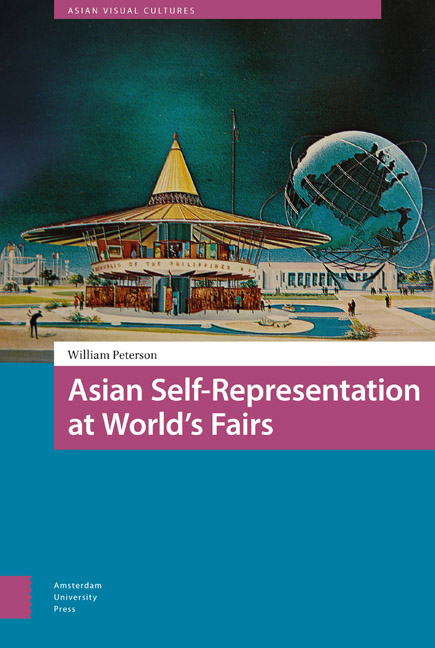Book contents
- Frontmatter
- Dedication
- Contents
- List of Figures
- Acknowledgements
- Note on Works Cited
- Note on Asian Names
- 1 Introduction: Setting the Stage
- 2 The Master of the Form: Japan at San Francisco's 1915 Panama-Pacific International Exposition
- 3 The New China and Chinese-Americanness: China at San Francisco's 1915 Panama-Pacific International Exposition
- 4 Performing Japan in the ‘World of Tomorrow’: Japan at the 1939-1940 New York World's Fair
- 5 From ‘Panda Diplomacy’ to Acrobat Diplomacy: China at the Brisbane's Expo ‘88
- 6 Fashion, Dance, and Representing the Filipina: The Philippines at the 1964-1965 New York World's Fair
- 7 Performing Modernity under Sukarno's ‘Roving Eye’: Indonesia at the 1964-1965 New York World's Fair
- 8 Maximizing Affect, Minimizing Impact with Hansik: South Korea at the 2015 Milan International Exposition
- 9 Hard and Soft Power in the Thai Pavilion: The Spectral Presence of King Bhumibol at the 2015 Milan Exposition
- 10 Conclusion: The Future of Asian Self-Representation at the International Exposition
- Works Cited
- Index
9 - Hard and Soft Power in the Thai Pavilion: The Spectral Presence of King Bhumibol at the 2015 Milan Exposition
Published online by Cambridge University Press: 21 November 2020
- Frontmatter
- Dedication
- Contents
- List of Figures
- Acknowledgements
- Note on Works Cited
- Note on Asian Names
- 1 Introduction: Setting the Stage
- 2 The Master of the Form: Japan at San Francisco's 1915 Panama-Pacific International Exposition
- 3 The New China and Chinese-Americanness: China at San Francisco's 1915 Panama-Pacific International Exposition
- 4 Performing Japan in the ‘World of Tomorrow’: Japan at the 1939-1940 New York World's Fair
- 5 From ‘Panda Diplomacy’ to Acrobat Diplomacy: China at the Brisbane's Expo ‘88
- 6 Fashion, Dance, and Representing the Filipina: The Philippines at the 1964-1965 New York World's Fair
- 7 Performing Modernity under Sukarno's ‘Roving Eye’: Indonesia at the 1964-1965 New York World's Fair
- 8 Maximizing Affect, Minimizing Impact with Hansik: South Korea at the 2015 Milan International Exposition
- 9 Hard and Soft Power in the Thai Pavilion: The Spectral Presence of King Bhumibol at the 2015 Milan Exposition
- 10 Conclusion: The Future of Asian Self-Representation at the International Exposition
- Works Cited
- Index
Summary
Abstract
With the much-loved King Bhumibol Adulyadej (r.1946-2016) on his virtual deathbed while the 2015 Milan International Exposition was being planned and became operational, it is hardly surprising that the pavilion's content reflected the nation's anxieties more acutely than it engaged with the fair’s food-oriented theme. While the exterior of the national pavilion expressed an organic, earthy quality that departed for the usual iconic Thai temple architecture, the interior offered up a series of three discrete sites in which fairgoers were bombarded with visual stimuli that conflated the country's abundant natural resources with corporatized food production, ultimately wrapping it up in a paean to the King for his role in virtually single-handedly creating a more efficient agricultural sector.
Keywords: Thailand, soft power, King Bhumibol, food
The case of Thailand at the 2015 Milan Expo is fascinating not only for how it chose to represent itself, but for what it revealed about the nation’s domestic dramas and political anxieties at a moment when the country’s beloved, long-serving monarch, King Bhumibol Adulyadej (r. 1946-2016), was on his deathbed. Ever-present despite his physical absence, the King who had become a virtual quasi-divine figure over the course of his reign was both the means and the message for the audience as they moved through the pavilion's three dedicated halls. The overall exposition theme, ‘Feeding the Planet, Energy for Life,’ provided an opportunity for Thailand to present itself as ‘the Golden Land,’ one blessed by human and supernatural forces, placing it in a unique position to respond to food security issues with its corporatized food production and an agricultural sector under the stewardship of a wise king. As was the case with Korea, the fair's theme tapped into a pre-existing international campaign centred around food; yet unlike Korea's campaign, which in the years prior to the expo focused on increasing the number of Korean restaurants overseas, Thailand's campaign sought to further international markets for pre-packaged foods manufactured by the country's largest food corporations. Thus, corporate interests were aligned with those of the state in ways that reflect both the nexus of power, politics, and influence in Thailand in an age that has moved beyond capitalism into what Edward Luttwak identifies as ‘turbo-capitalism’ (Luttwak 1998).
- Type
- Chapter
- Information
- Asian Self-Representation at World's Fairs , pp. 255 - 278Publisher: Amsterdam University PressPrint publication year: 2020

